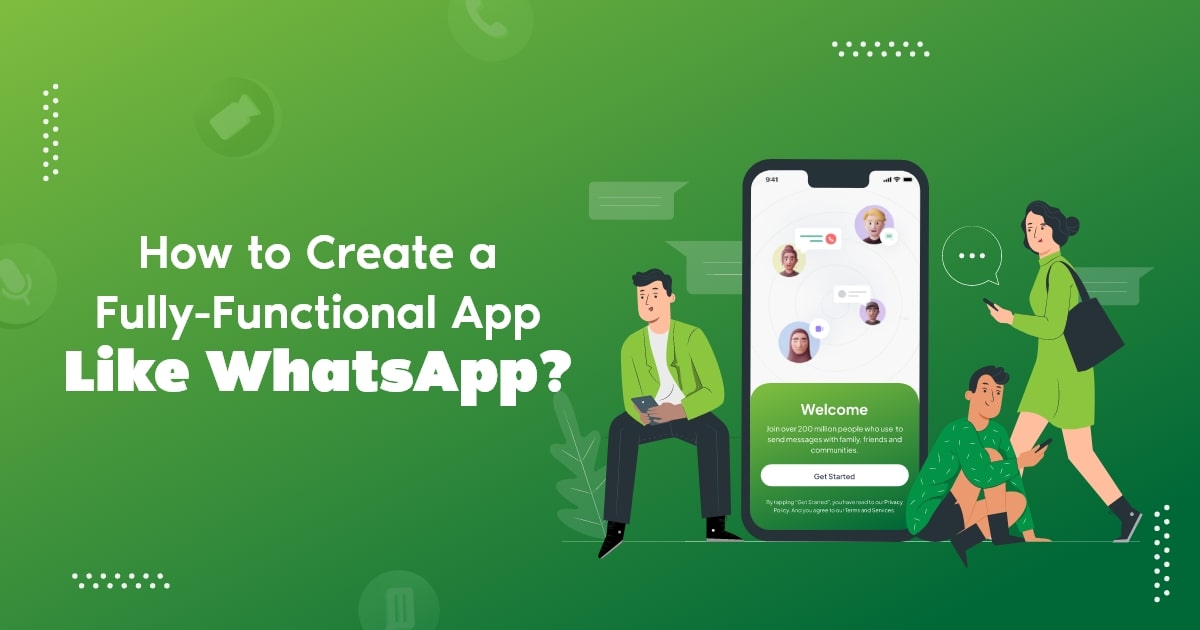Introduction
In the fast-paced digital era, communication plays a pivotal role in connecting people across the globe. Messaging apps have become an integral part of our daily lives, and WhatsApp stands out as a frontrunner with its user-friendly interface, secure messaging, and innovative features. If you're inspired to building an app like WhatsApp, this comprehensive guide will walk you through the key steps and considerations to turn your vision into reality.
Understanding the Market
Before embarking on the journey of building an app like WhatsApp, it's crucial to understand the market dynamics. Analyze existing messaging apps, identify their strengths and weaknesses, and pinpoint the unique features that set WhatsApp apart. This market research will help you define your target audience, understand user expectations, and refine your app development strategy.
Key Features of WhatsApp
WhatsApp's success is attributed to its simplicity, security, and an array of features that cater to user needs. To build a successful messaging app, consider incorporating the following key features:
- User Registration and Authentication:
- Implement a seamless registration process with phone number verification.
- Ensure robust authentication mechanisms to protect user data.
- User Profile:
- Allow users to create and customize profiles with profile pictures, status updates, and other personal information.
- Instant Messaging:
- Develop real-time messaging capabilities with text, images, videos, and voice messages.
- Implement features like read receipts and typing indicators for a more interactive user experience.
- Group Chats:
- Enable users to create and participate in group chats with a user-friendly interface.
- Implement administrative controls for group admins.
- Multimedia Sharing:
- Support seamless sharing of multimedia files, including photos, videos, and documents.
- Voice and Video Calls:
- Integrate high-quality voice and video calling features for real-time communication.
- End-to-End Encryption:
- Prioritize user security by implementing end-to-end encryption to protect messages from unauthorized access.
- Status Updates:
- Allow users to share updates and stories with their contacts, enhancing the social aspect of the app.
- Notifications:
- Implement push notifications to keep users informed about new messages and activities within the app.
Choosing the Right Tech Stack
Selecting the right technology stack is crucial for the success of your messaging app. Consider the following components:
- Programming Language:
- Choose a programming language suitable for mobile app development, such as Swift for iOS and Kotlin/Java for Android.
- Backend Development:
- Utilize a robust backend framework like Node.js, Django, or Ruby on Rails for server-side development.
- Database:
- Opt for a scalable and secure database system like MongoDB, PostgreSQL, or MySQL to handle user data efficiently.
- Real-time Communication:
- Implement WebSocket technology for real-time communication, ensuring instant message delivery.
- Cloud Services:
- Leverage cloud services like AWS or Google Cloud for scalable storage and reliable infrastructure.
User Interface (UI) and User Experience (UX) Design
The success of a messaging app heavily relies on its user interface and user experience. Work with skilled designers to create an intuitive and visually appealing design that resonates with your target audience. Prioritize simplicity, ensuring that users can navigate the app effortlessly. Pay attention to color schemes, typography, and iconography to create a cohesive and aesthetically pleasing design.
Development Process
- Wireframing and Prototyping:
- Start with wireframing to visualize the app's structure and flow.
- Create prototypes to demonstrate the app's functionality and gather feedback.
- Frontend Development:
- Develop the frontend of the app, focusing on responsiveness and a seamless user experience.
- Implement features such as chat interfaces, multimedia sharing, and user profiles.
- Backend Development:
- Build a robust backend that can handle user authentication, message storage, and other core functionalities.
- Implement a secure server with end-to-end encryption to protect user privacy.
- Integration of Features:
- Integrate key features like voice and video calling, group chats, and multimedia sharing into the app.
- Testing:
- Conduct thorough testing to identify and rectify any bugs or issues.
- Perform usability testing to ensure a positive user experience.
- Deployment:
- Deploy the app on app stores, ensuring compliance with their guidelines.
- Monitor user feedback and address any issues promptly.
Security and Privacy
Given the sensitive nature of personal communication, prioritize security and privacy in your messaging app. Implement end-to-end encryption to ensure that messages are secure and inaccessible to unauthorized parties. Regularly update your app to patch any security vulnerabilities and stay ahead of potential threats.
Monetization Strategies
Once your app is live, consider various monetization strategies to make your project financially sustainable. Some common approaches include:
- Freemium Model:
- Offer basic features for free and charge users for premium features or additional functionalities.
- In-App Purchases:
- Allow users to purchase virtual goods, stickers, or themes within the app.
- Subscription Plans:
- Introduce subscription plans for premium services, such as enhanced storage or exclusive features.
- Ads:
- Incorporate non-intrusive ads to generate revenue, ensuring they do not compromise the user experience.
Marketing and Promotion
To ensure the success of your messaging app, invest in effective marketing and promotion strategies. Utilize social media platforms, influencer marketing, and other digital channels to create awareness and attract users. Highlight the unique features of your app and showcase how it addresses user needs and preferences.
Conclusion
Building an app like WhatsApp requires careful planning, technical expertise, and a deep understanding of user expectations. By focusing on key features, choosing the right technology stack, prioritizing UI/UX design, and emphasizing security, you can create a messaging app that stands out in a competitive market. Additionally, effective marketing and monetization strategies will contribute to the long-term success and sustainability of your app. Keep innovating, stay responsive to user feedback, and continually refine your app to meet the evolving needs of your user base.





Comments